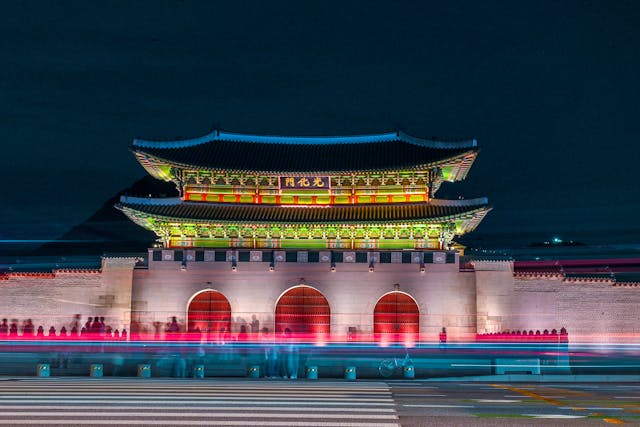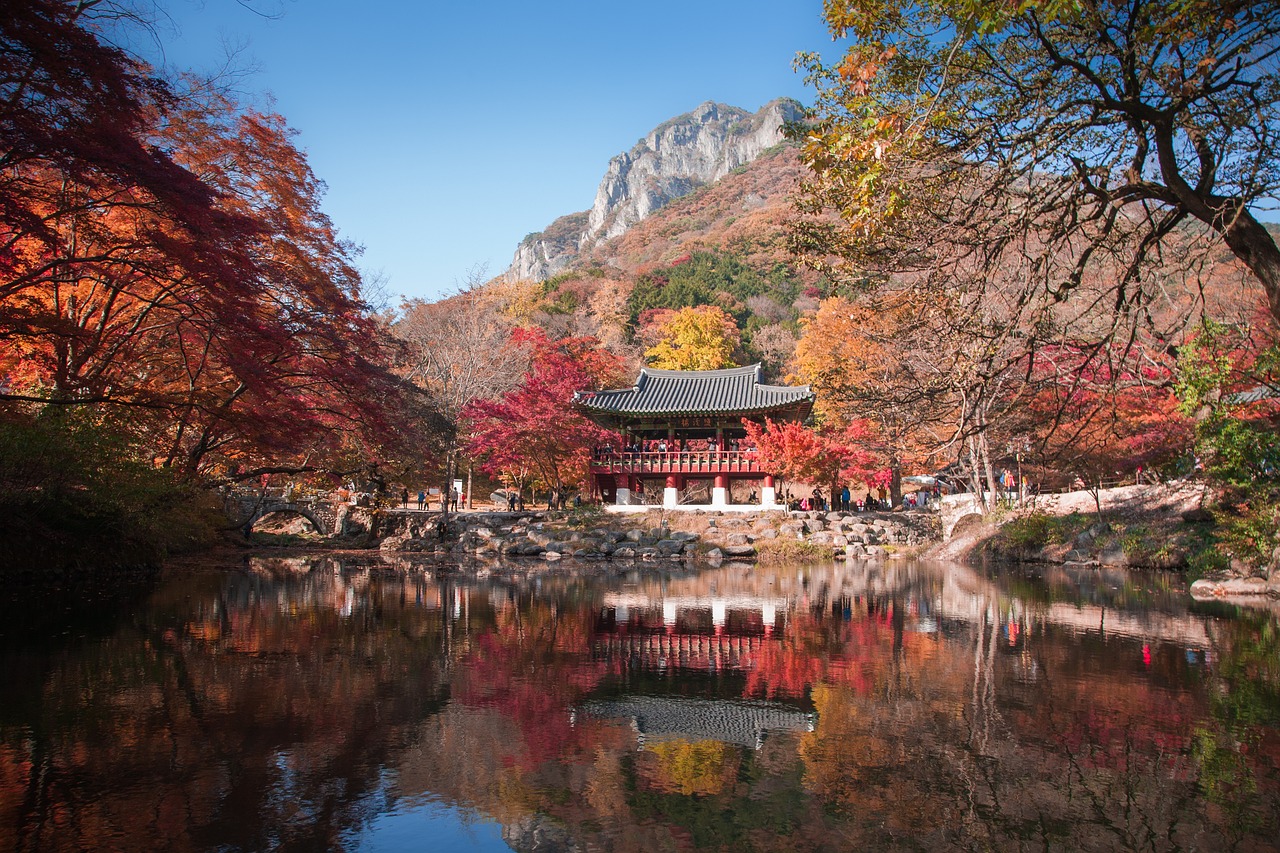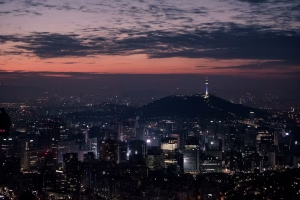South Korea in February is a magical blend of winter charm, cultural festivities, and mouthwatering food. The month brings snowy landscapes, vibrant events, and plenty of opportunities to experience Korea’s unique traditions. Whether you’re an adventure seeker or a culture enthusiast, February offers something for everyone.
This blog serves as your ultimate guide to exploring South Korea in February. We’ve covered everything from weather conditions and cultural highlights to must-visit places and essential tips to ensure a memorable trip.
- Is February a Good Time to Visit South Korea?
- Weather in South Korea in February
- Cultural Experiences in South Korea in February
- Events & Festivals in February in South Korea
- Top Things to Do in South Korea
- Famous Places to Eat in South Korea
- What to Pack for February?
- Where to Stay in South Korea?
- Average Cost of a Trip to South Korea
- Why Choose OneVasco?
- FAQs
Is February a Good Time to Visit South Korea?
February is a fantastic time to visit South Korea for travelers who enjoy winter activities, scenic snowy landscapes, and unique cultural experiences. While the weather is cold, it creates the perfect ambiance for outdoor adventures like skiing and ice fishing.
Additionally, February sees fewer tourists than spring and autumn, making it an excellent time for exploring popular destinations without the crowds.
Pros:
- Winter Wonderland: Snow-covered landscapes and winter festivals.
- Fewer Crowds: Enjoy tourist spots more peacefully.
- Seasonal Cuisine: Indulge in hearty winter dishes like tteokguk and galbitang.
Cons:
- Cold Temperatures: Might not suit travelers sensitive to cold weather.
- Limited Greenery: Lack of spring blossoms or autumn foliage.
Recommendation:
February is perfect for winter enthusiasts and those seeking cultural immersion through unique festivals and traditional experiences.
**Planning a trip to experience South Korea in February? Ensure your visa and travel documents are ready with the help of OneVasco for a stress-free journey.
Weather in South Korea in February
The weather in South Korea during February is cold and dry, with occasional snowfall. However, the crisp air and sunny skies make it comfortable for outdoor exploration. For a detailed overview, check out this South Korea weather guide for February:
|
Weather Element |
Details |
|
Temperature (°C) |
High: 4°C |
|
Humidity |
Around 60% |
|
Chances of Rainfall |
Minimal |
|
Average Precipitation |
25-30 mm |
|
Number of Rainy Days |
4-6 days |
|
Time of Rainfall |
Morning and late evening, if any |
Cultural Experiences in South Korea in February
February offers rich cultural experiences, from exploring historic palaces to witnessing traditional Korean performances. The winter season adds a special charm to these activities.

- Hanbok Experience: Rent a traditional Korean outfit and explore royal palaces like Gyeongbokgung or Changdeokgung.
- Temple Stays: Immerse yourself in Korean Buddhism by staying overnight in temples like Beomeosa or Jogyesa.
- Korean Tea Ceremony: Participate in a traditional tea ceremony to understand Korean etiquette and culture.
Events & Festivals in February in South Korea
February is vibrant, with winter festivals and cultural celebrations across the country.
Hwacheon Sancheoneo Ice Festival
This festival celebrates ice fishing in Hwacheon, Gangwon Province, and attracts thousands of visitors each year. Visitors can fish for mountain trout, participate in snow sledding, and enjoy local cuisine.
- Location: Hwacheon, Gangwon Province
- Time: Early to mid-February
- Specialties: Ice fishing, snow sculptures, sledding
Visit the official website for more details about the festival.
Suggested Article: Winter in South Korea
Jeju Fire Festival
Celebrated on Jeju Island, this event symbolizes good harvests and happiness. Highlights include bonfires, traditional games, and folk performances.
- Location: Jeju Island
- Time: Mid-February
- Specialties: Traditional rituals, bonfire displays
Learn more about the festival on the official website.
Pyeongchang Trout Festival

Located in the snowy region of Pyeongchang, this festival is all about fishing, snow activities, and delicious trout dishes.
- Location: Pyeongchang, Gangwon Province
- Time: February (dates vary annually)
- Specialties: Ice fishing, trout BBQ, sledding
Suggested Article: Festivals in South Korea
Top Things to Do in South Korea
February in South Korea offers a mix of thrilling winter activities, cultural immersion, and scenic beauty. From skiing in world-class resorts to exploring picturesque villages, every experience is unforgettable. Here are some of the best activities in South Korea in February that you can include in your trip:
1. Skiing in Pyeongchang

Known for hosting the Winter Olympics, Pyeongchang is a paradise for ski enthusiasts. Resorts like Yongpyong and Alpensia offer well-maintained slopes suitable for beginners and advanced skiers alike. You can also enjoy snowboarding, sledding, and après-ski activities at these resorts.
2. Visiting Nami Island
Nami Island transforms into a winter wonderland in February, making it ideal for romantic strolls or family outings. The snow-covered tree-lined paths and cozy cafes provide a serene escape from the bustling city life. The island is easily accessible via ferry from Gapyeong.
Suggested Article: Sweden in February
3. Exploring Bukchon Hanok Village

This traditional village in Seoul is home to beautifully preserved hanoks (Korean houses). Strolling through the snowy streets feels like stepping back in time. Many hanoks function as cultural centers where you can participate in craft workshops or tea ceremonies.
4. Enjoying a Traditional Jjimjilbang
South Korea’s jjimjilbangs, or bathhouses, are the ultimate relaxation experience. Soak in hot baths, sweat out toxins in saunas, and enjoy traditional Korean body scrubs. Dragon Hill Spa in Seoul is one of the most famous spots for tourists.
Suggested Article: Winter in Japan
5. Hiking in Seoraksan National Park

Seoraksan National Park is a hiker’s paradise with trails that offer stunning views of snow-covered peaks. February adds a magical touch with frozen waterfalls and serene winter landscapes. The park is also home to hot springs where you can unwind after a trek.
From skiing in the mountains to exploring vibrant markets, February is full of adventures in South Korea. Start your journey stress-free by reading our blog on how to check your South Korea visa status for quick visa processing.
Famous Places to Eat in South Korea
South Korea is a food lover’s paradise, offering a rich variety of flavors, textures, and culinary experiences. Here are some must-visit places to eat while in South Korea:
1. Gogung (Seoul)
Gogung is a must-visit for those wanting to experience authentic Korean bibimbap, a mixed rice dish topped with fresh vegetables and meat. Located in Insadong, the restaurant’s warm ambiance complements its flavorful offerings. Gogung also serves vegetarian and vegan options, catering to all dietary preferences.
- Location: Insadong, Seoul
- Opening Hours: 11:30 AM – 9:30 PM
- Specialties: Bibimbap, Bulgogi
- Additional Info: Reservations are recommended during peak hours.
Suggested Article: Winter in South Africa
2. Gwangjang Market (Seoul)

Famous for its vibrant atmosphere, Gwangjang Market is a haven for street food lovers. Enjoy hot dishes like tteokbokki (spicy rice cakes) and bindaetteok (mung bean pancakes) as you explore the bustling food stalls. The market is perfect for sampling diverse Korean snacks and drinks on a budget.
- Location: Jongno-gu, Seoul
- Opening Hours: 9:00 AM – 10:00 PM
- Specialties: Bindaetteok, Kimbap, Tteokbokki
- Additional Info: Ideal for casual dining and late-night snacks.
3. Jeonju Hanok Village Food Street (Jeonju)
Jeonju is the birthplace of bibimbap, and the food street in Hanok Village offers the most authentic version. The area is lined with hanok-style restaurants serving hearty Korean dishes. Besides bibimbap, try Jeonju’s famous choco pie, a locally beloved dessert.
- Location: Jeonju Hanok Village, Jeonju
- Opening Hours: 10:00 AM – 9:00 PM
- Specialties: Jeonju Bibimbap, Choco Pie
- Additional Info: The area also features tea houses and souvenir shops.
Suggested Article: Markets in South Korea
4. Jagalchi Fish Market (Busan)
For seafood enthusiasts, Jagalchi Fish Market in Busan is a must-visit destination. The market offers the freshest seafood, from grilled mackerel to live octopus. Upstairs restaurants allow you to select your catch and have it prepared immediately.
- Location: Nampo-dong, Busan
- Opening Hours: 5:00 AM – 10:00 PM
- Specialties: Grilled Mackerel, Raw Fish Platters
- Additional Info: The market is perfect for adventurous foodies eager to try raw or live seafood.
5. Tosokchon Samgyetang (Seoul)

Famous for its ginseng chicken soup, Tosokchon is a favorite among locals and tourists alike. The rich broth, stuffed with rice, ginseng, and medicinal herbs, is perfect for cold February days. The traditional hanok setting adds an authentic touch to the dining experience.
- Location: Jongno-gu, Seoul
- Opening Hours: 10:00 AM – 10:00 PM
- Specialties: Samgyetang (Ginseng Chicken Soup)
- Additional Info: It is often crowded, so visiting during off-peak hours is recommended.
Suggested Article: South Korea Famous Food
What to Pack for February?
Packing for South Korea in February requires careful planning to stay warm and comfortable during your trip.
1. Warm Clothing
Pack thermal layers, sweaters, and insulated jackets to combat the cold. Don’t forget woolen scarves, gloves, and hats for extra warmth.
2. Waterproof Items
Though February has minimal rainfall, waterproof boots and jackets are useful if you plan to visit snowy regions like Pyeongchang or Nami Island.
3. Accessories
Portable hand warmers, a sturdy travel umbrella, and lip balm are essential. These small items can make a big difference in staying comfortable during outdoor activities.
4. Footwear
Insulated, slip-resistant shoes are crucial for walking on icy or snowy surfaces. Comfortable sneakers are also suitable for exploring cities.
5. Electronics
Bring a universal adapter, power bank, and extra batteries for cameras since cold temperatures can drain battery life quickly.
Where to Stay in South Korea?

South Korea offers a variety of accommodation options to suit every traveler’s needs and budget.
1. Luxury Stays
- Recommendation: Signiel Seoul (Lotte World Tower)
- Highlights: Unmatched views of the city, world-class dining, and spa facilities.
2. Mid-Range Hotels
- Recommendation: Shilla Stay, Gangnam
- Highlights: Convenient location, clean and modern rooms, and great breakfast options.
3. Budget-Friendly Options
- Recommendation: Lazy Fox Hostel, Hongdae
- Highlights: Affordable prices, cozy rooms, and a lively neighborhood with cafes and street performers.
4. Unique Accommodations
- Recommendation: Hanok stays in Jeonju or Bukchon
- Highlights: Immerse yourself in traditional Korean culture by staying in a hanok with ondol (heated floors).
South Korea has various stay options, from cozy guesthouses to luxury hotels. Ensure you have your visa ready before you go. Check out our guide on how to check your South Korea visa status and book your dream accommodation!
Average Cost of a Trip to South Korea
Planning your budget for a trip to South Korea in February ensures a smooth and enjoyable experience. Costs can vary depending on travel preferences, accommodation types, and activities. Below is an approximate breakdown of the costs for different aspects of your trip, converted into INR (1 KRW = 0.063 INR as of the current exchange rate).
1. Flights
Flight prices can fluctuate depending on the season, booking time, and airline. February tends to have slightly lower airfares compared to the peak spring and autumn seasons.
- Average Cost: ₹25,000 – ₹80,000 (round-trip)
- Pro Tip: Book flights 2-3 months in advance for the best deals.
2. Accommodation
South Korea offers a wide range of accommodations, from budget hostels to luxury hotels. Prices in popular cities like Seoul and Busan are slightly higher but still affordable compared to global standards.
- Budget stays (hostels or guesthouses): ₹1,500–₹3,000 per night.
- Mid-range hotels: ₹5,000–₹8,000 per night.
- Luxury hotels: ₹12,000–₹25,000 per night.
- Unique stays (hanok houses): ₹6,000–₹12,000 per night.
Pro Tip: Book accommodations near metro stations for easier access to attractions.
Suggested Article: Winter in Germany
3. Transportation
South Korea’s public transportation system is efficient, affordable, and well-connected. A transport card, such as the T-Money card, can save you time and effort while navigating major cities.
- T-Money card (for public transport): ₹400–₹800 (initial top-up).
- Subway or bus fare (one-way): ₹50–₹200 per ride.
- Taxis: ₹150–₹300 per km, depending on the city and time of travel.
- Intercity travel (KTX high-speed trains): ₹3,000–₹6,000 per trip.
- Pro Tip: Get a T-Money card for hassle-free metro and bus rides.
4. Food and Dining
South Korea is a paradise for food lovers, offering everything from affordable street food to lavish fine dining. Budget travelers can easily survive on delicious local food without breaking the bank. Fine dining experiences or specialty dishes like Hanwoo beef can cost upwards of ₹5,000 per person.
- Street food/snacks: ₹250–₹500 per meal.
- Casual dining at local restaurants: ₹800–₹1,500 per meal.
- Fine dining: ₹3,000–₹6,000 per meal.
- Pro Tip: Explore local markets for authentic and affordable Korean meals.
Suggested Article: Nightlife in South Korea
5. Sightseeing and Activities
Entry fees to attractions in South Korea are relatively inexpensive. Many landmarks, temples, and hiking trails are free, while popular destinations charge nominal fees.
- Palaces and Museums: ₹200–₹500 per ticket.
- Theme Parks (Everland/Lotte World): ₹3,500–₹5,000 per ticket.
- Skiing/Snowboarding: ₹4,000–₹8,000 per day (including gear rental).
- Cultural Experiences (e.g., Hanbok Rental): ₹1,000–₹2,000.
- Pro Tip: Check for discounts on attraction bundles and city passes.
6. Shopping
Shopping in South Korea can be tailored to your budget. From trendy street markets to high-end malls, the options are endless.
- Street Markets (souvenirs and clothing): ₹500–₹2,000 per item.
- Skincare/Beauty Products: ₹1,000–₹5,000 per item.
- Luxury Brands (in Gangnam): ₹10,000 and above.
- Pro Tip: Bargain at flea markets for better deals on souvenirs.
7. Total Estimated Cost
Don’t forget to budget for essentials like travel insurance, tips, and extra purchases. Travel insurance is highly recommended for peace of mind during your trip.
- Travel Insurance: ₹1,500–₹3,000 (for a week).
- Tips: Not customary but appreciated for exceptional service (₹50–₹200).
- Extras (Wi-Fi rental or SIM card): ₹500–₹1,000 for a week.
- Pro Tip: Set aside extra funds for spontaneous activities and shopping splurges.
**Planning your budget for South Korea in February? Read our blog on how to apply for a South Korea visa extension and simplify your visa extension process so you can focus on your travel expenses.
Why Choose OneVasco?
OneVasco makes visa applications effortless. Our expert team manages the entire process, allowing you to focus on your journey.
Enjoy stress-free travel with fast visa approvals.
- Expert and Personalized Support
- Efficient and Hassle-Free Process
- Real-Time Tracking and Updates
- Transparent Communication
- Trusted by Millions
FAQs
Is February a good time to visit South Korea?
Yes, February is a great time to visit South Korea if you enjoy winter activities, fewer crowds, and seasonal festivals. You can experience snow-covered landscapes, enjoy skiing resorts, and attend events like the Jeju Fire Festival.
Does it snow in Seoul in February?
Yes, Seoul often experiences snowfall in February, though it’s not guaranteed. The city’s winter ambiance is magical, with cold weather and occasional snow transforming the streets into picturesque scenes.
When is the best time to visit South Korea?
The best time to visit South Korea is during spring (April to June) and autumn (September to November). These seasons offer mild weather, vibrant colors, and plenty of cultural festivals.
Which city in South Korea is best to visit in February?
Seoul is ideal for February visits, offering winter attractions like snow parks and cultural sites. Additionally, Gangwon Province is perfect for skiing enthusiasts, and Jeju Island hosts the unique Fire Festival.
How many days in South Korea is enough?
A 7 to 10-day trip is ideal to explore South Korea’s major attractions. This allows you to experience Seoul, Busan, and other key destinations while enjoying the local culture and cuisine.





















